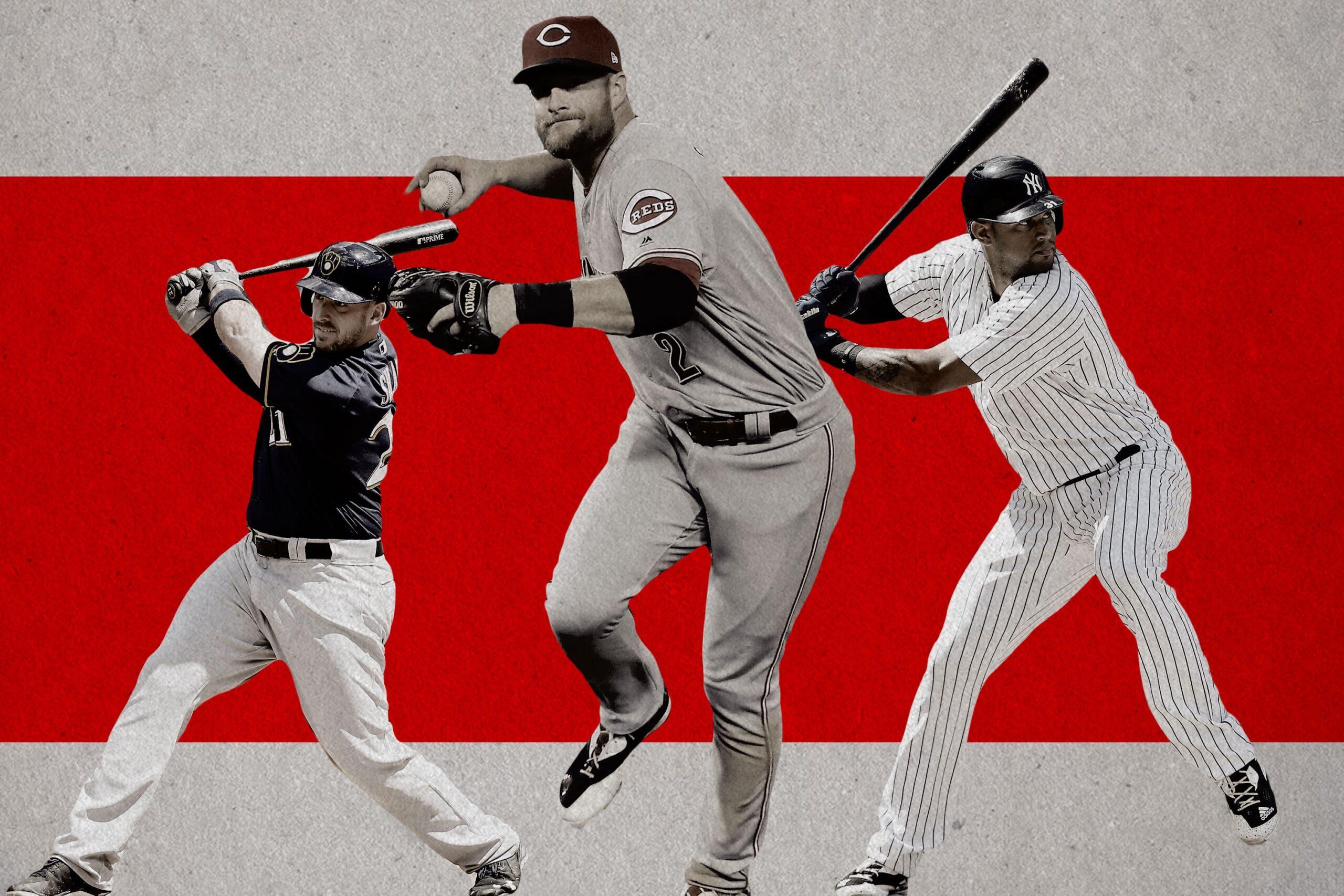
A year after striking out in half of his MLB at-bats, Aaron Judge leads the majors in WAR. The home run leaderboard features two rookies and a host of surprise first basemen near the top. Of the nine players set to feature in the American League’s starting lineup on Tuesday, six are first-time All-Stars.
The first half of the 2017 season was defined by the breakout, as burgeoning home run totals served as a democratizing agent, spreading the wealth to all corners of the baseball landscape. When everyone can hit homers, previously mediocre or struggling players can find a path to stardom. Some of them received the actual honor of making Tuesday’s rosters, while others were passed over in favor of more established names or other surprise performers. No matter. Here, we’re honoring them all, actual All-Stars and snubs alike, with a roster detailing the best and most surprising breakouts of the season’s first half.
Catcher: Tyler Flowers, Braves
Flowers has been the best defensive catcher in baseball thus far, as well as the third-most productive batter at his position. He should have been an All-Star. Read Ben Lindbergh’s story on the most shockingly valuable player this year.
Additional consideration to Manny Piña, Brewers, and Austin Barnes, Dodgers.
First Base: Justin Smoak, Blue Jays
First base has the fiercest competition for the “most surprising” honor, but Smoak, who carried a below-average bat for nearly 3,000 plate appearances before this year, has the slightest edge over his peers. The switch-hitting Blue Jay has already set a career high in homers (23). He’s chopped his strikeout rate almost in half from last season. He’s increased his career WAR from 0.2 to 2.4. He’s navigated the common career path from top prospect to traded-for-an-ace top prospect to failed top prospect, only to buck the trend by breaking out half a decade later. A below-replacement-level player in 2016, Smoak would now need to make outs in his next 140 at-bats for his 2017 slugging percentage to fall to his pre-2017 career mark.
Additional consideration to Logan Morrison, Rays; Yonder Alonso, Athletics; Justin Bour, Marlins; and Mark Reynolds, Rockies.
Second Base: Scooter Gennett, Reds
Through Saturday’s games, 121 players both qualified for last year’s batting title and had recorded at least 200 plate appearances this season. Nobody from that group has added more to his slugging percentage than Gennett (a 202-point increase), and only Houston’s Marwin González has added more to his wRC+ (Gennett is tied with Alonso in second place, with a 61-point increase that’s good enough for a batting line 51 percent better than league average).
Only a week before the 2017 season started, the Brewers waived Gennett, whose WAR total had declined each year since a promising rookie campaign with Milwaukee in 2013, and the Reds picked him up as a utility replacement. They certainly didn’t envision Gennett forcing his way into the everyday lineup with such a hot bat: He started only 18 games in April and May combined, then nabbed 19 starts in June alone. He also hit four home runs in a game, and while the ball is juiced, Gennett deserves ample credit as the only player to accomplish that feat since this high-homer era began in 2015.
Additional consideration to Jonathan Schoop, Orioles, and Eric Sogard, Brewers.
Third Base: Travis Shaw, Brewers
Shaw was a decent but not great hitter in two seasons in Boston, posting a cumulative 97 wRC+ and averaging one homer per every 27 plate appearances. Hitting in the middle of Milwaukee’s surprisingly division-leading lineup, he’s upped that production to a 138 wRC+ and one homer per every 17 PAs, and he leads all Brewers position players with 2.6 WAR. His production is particularly galling for the Red Sox, who traded Shaw as part of an offseason package for reliever Tyler Thornburg. Fast-forward seven months: Thornburg hasn’t thrown a pitch in 2017 and recently underwent surgery to treat thoracic outlet syndrome, while the Red Sox are in a tie for the worst-hitting group of third basemen in the majors.
Additional consideration to Jedd Gyorko, Cardinals, and Eugenio Suárez, Reds.
Shortstop: Zack Cozart, Reds
Cozart’s monthly wRC+ has fallen from 171 in April to 161 in May to 99 in June to 76 so far in July. That’s a bad trend, but his start was sufficiently hot as to make his season-long mark (143) the second-best among all shortstops. He’s out-hitting Francisco Lindor, Xander Bogaerts, and Trea Turner by significant margins and Corey Seager by a smidge, and he’s playing his customarily strong defense at the diamond’s most important position. He’s a worthy new donkey owner.
Additional consideration to Tim Beckham, Rays, and Andrelton Simmons the hitter, Angels.
Left Field: Chris Taylor, Dodgers
This selection is a bit of a cheat because Taylor has split his time between five positions, but he has played most often in the outfield, and the competition in left is meager, so the Dodger will do. At the All-Star break, he’s accumulated nearly as many plate appearances this year as he had in his MLB career before 2017. A comparison between those previous numbers and this year’s illustrates Taylor’s turnaround.
Before 2017: 318 plate appearances, .234/.289/.309 slash line, 1 home run, 17 RBI, 69 wRC+
First half, 2017: 277 plate appearances, .285/.365/.480 line, 10 home runs, 38 RBI, 127 wRC+
The Dodgers acquired Taylor from Seattle last summer in a low-profile trade for pitcher Zach Lee, who has since been designated for assignment by two different teams. L.A. has a lot of money, but its roster construction via savvy depth moves has been just as essential to propelling the team to the best record in baseball.
Center Field: Aaron Hicks, Yankees
The former Twin was a top-100 guy by both Baseball America’s and Baseball Prospectus’ rankings four times, but his prospect luster had long since worn off by the start of this year, as Hicks posted a .223/.299/.346 line through his first 1,289 career plate appearances. He was still a viable defensive outfielder and base runner, but his offensive production cratered his overall value, making him worth just 0.8 career WAR. In 2017, he’s already accumulated 2.7 wins above replacement, ranking him third among all center fielders despite fewer games played than every other non–Mike Trout player in the top eight.
Additional consideration to Michael Taylor, Nationals, and Cameron Maybin, Angels.
Right Field: Aaron Judge, Yankees
In the batting section of any given hitter’s Baseball-Reference page, a bolded statistic denotes that the player leads his league in that category, and a bolded, italicized statistic denotes that the player leads the majors. Here’s what Judge’s batting line looks like as of Sunday afternoon:.

And in the scant categories he doesn’t lead, he’s still close to the top, ranking second in the AL in RBI and third in batting average. Judge’s half-season for the ages is the top story line of the first half, and it isn’t particularly close.
Additional consideration to Steven Souza, Rays; Avisaíl García, White Sox; and Scott Schebler, Reds.
Starting Pitcher: Jason Vargas, Royals
The AL’s ERA leader is not Chris Sale, who is on pace for well over 300 strikeouts. It’s not Corey Kluber, who’s been the majors’ best pitcher over the last month. It’s not Dallas Keuchel, whose injuries have left him about a dozen innings short of qualifying for the leaderboard, and it’s not Rick Porcello, David Price, or Justin Verlander, who have all won Cy Young awards in the past six years. Rather, it’s Jason Vargas, a journeyman southpaw who pitched 55 innings combined over the previous two seasons, and whose 2.62 ERA would represent his best-ever mark in a qualified season by more than a full run. He’s not doing anything differently on the mound, but he’s not giving up any homers, and in 2017, that might be the most standout trait a pitcher can possess.
Additional consideration to Jimmy Nelson and Chase Anderson, Brewers; Zack Godley, Diamondbacks; and Alex Wood, Dodgers, who had just enough success in the past to push him below Vargas.
Reliever: All of them
The pitching equivalent to the home run trend is an ever-increasing rise in strikeouts, particularly in the bullpen, and it’s too hard to narrow down a list of all the pop-up relievers in this velocity- and K-happy era. Seemingly every bullpen now has a few relievers who combine a 98 mph fastball with a wicked slider, and many of those arms were anonymous until they started striking out every MLB hitter in sight. Among those who’ve pitched at least 20 innings, 37 relievers are striking out at least 30 percent of opposing hitters; 10 years ago, that number was 12. This year’s list features the Craig Kimbrels and Andrew Millers of the bullpen, sure, but it also includes Tommy Kahnle, James Hoyt, José Leclerc, Joe Smith, Chris Devenski, Kirby Yates, Blake Parker, Chad Green, Andrew Chafin, Michael Feliz, and Bud Norris. Bud Norris! The new Angels closer’s career-best ERA before 2017 was 3.65; this year, it’s 2.29. He’s striking out a higher percentage of opposing hitters than Mariano Rivera ever managed in a season. There’s no more emblematic stat of the 2017 breakouts than that one.

